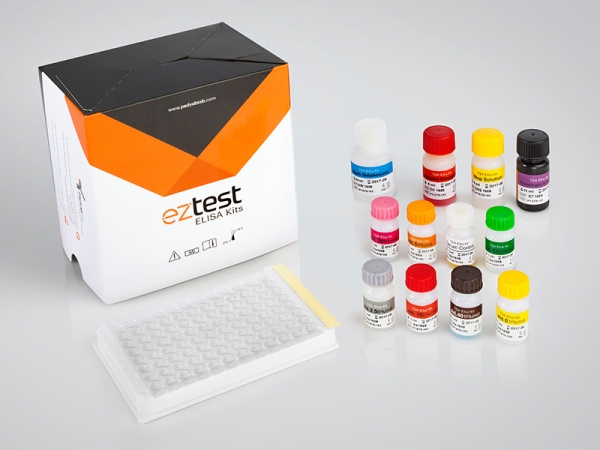| Name | T3 ELISA Test |
| Full name | Human T3 ELISA Test Kit |
| Category Name | Thyroid ELISA kits |
| Test | 96 |
| Method | ELISA method: Enzyme Linked Immunosorbent Assay |
| Principle | Competitive ELISA |
| Detection Range | 0-10 ng/mL |
| Sample | 50uL |
| Sensitivity | 0.2 ng/ml |
| Total Time | ~60 min |
| Shelf Life | 12 Months from the manufacturing date |
T3 ELISA kit description:
The T3 ELISA is intended for the quantitative determination of the Free Triiodothyronine (T3) concentration in human serum.
Materials provided with T3 ELISA Test Kit:
1. Anti-T3 Antibody-coated ELISA Microplate (96 wells)
2. T3 enzyme conjugate reagent: 1 Vials contains anti-T3-HRP with preservative buffer, ready to use.(1 Vials, 12 ml)
3. T3 standard set, contains 0, 0.5, 1, 2.5, 5, 10 ng/ml, ready for use. (6 vials. 1 ml)
4. TMB Substrate: Hydrogen peroxide and tetra-methyl benzidine in preservative buffer, ready to use. (1 vial of 11ml)
5. Stop Solution: a normal hydrochloric acid (1 vial, 6 ml).
6. Concentrated washing buffer: PBS-Tween (1 vial 30ml) (20X)
7. Control serum: T3 in serum with preservatives(1Vial, 1 ml)
Materials Required, not Provided:
1. Precision pipettes(50,100, µl)
2. Distilled or deionized water
3. EIA kit Microplate Washer
4. EIA kit Microplate Reader with a 450 nm, If possible, 630 nm as reference.
5. Absorbent paper
Introduction
3,5,3′ triiodothyronine (T3) hormone secreted by thyroid gland and circulates in the bloodstream, mostly bound to the plasma proteins, thyroxine binding globulin (TBG) and thyroxine-binding prealbumin (TBPA) . The concentration of T3 is much less than that of T4, but its metabolic potency is much greater. T3 hormone level is good indicator of thyroid disease state and body metabolism. T3 measurement has uncovered a variant of hyperthyroidism in thyrotoxic samples with elevated T3 values and normal T4 values. Likewise, an increase in T3 without an increase in T4 is frequently a forerunner of recurrent thyrotoxicosis in previously treated patients. Another clinical application of T3 is in patients with normal thyroid function that is verifiable only by natural concentration of T3 if even T4 concentration is low. T3 measurement is useful in monitoring under treatment patients with hyperthyroidism and also the treated patients that have stopped their treatment. T3 measurement is also valuable especially in hyperthyroidism and euthyroid diagnosis. In addition to hyperthyroidism, there are many circumstances in which the levels of TBG are not normal. For instance, pregnancy or estrogen therapy cause increases in T3 and T4, whereas androgenic steroids have the opposite effect; also, decreasing of TBG cause decrease in T3 and T4 too. Because of this variation in TBG levels, interpretation of T3 results do not show an accurate reflection of the activity of the thyroid gland.
In most hyperthyroid patients, both T3 and T4 levels are high but in some conditions like thyrotoxicosis, the T3 level is high but TBG and T4 levels are normal; also, high levels of T3 is seen in thyroid nodules and Plummer toxic adenoma.
Principle of the assay
This ELIZA assay utilizes a highly specific T3 monoclonal antibody. Test sample, T3 antibody solution and a buffer containing chemical blocking agents and T3-enzyme conjugate are added to each antibody coated well. In this method, 8-anilino-1-naphthalene sulfonic acid (ANS) is used that cause a release of T3 from the serum binding proteins and allow the T3 to bind to the antibody-coated well. During the incubation, T3-HRP and T3 in the patient's sera and standard compete with for binding to Anti-T3 monoclonal antibodies on the wells. After 45 minutes incubation period in room temperature, the wells are washed by washing solution. An enzyme substrate-chromogen is added to the well and incubated for 15 minutes at room temperature, resulting in the development of a blue color. The color development is stopped with the addition of Stop Solution and converts the color to yellow. The concentration of T3 in the patient sample is measured spectrophotometrically at 450nm.The intensity of the yellow color is inversely proportional to the concentration of T3 in the sample.



